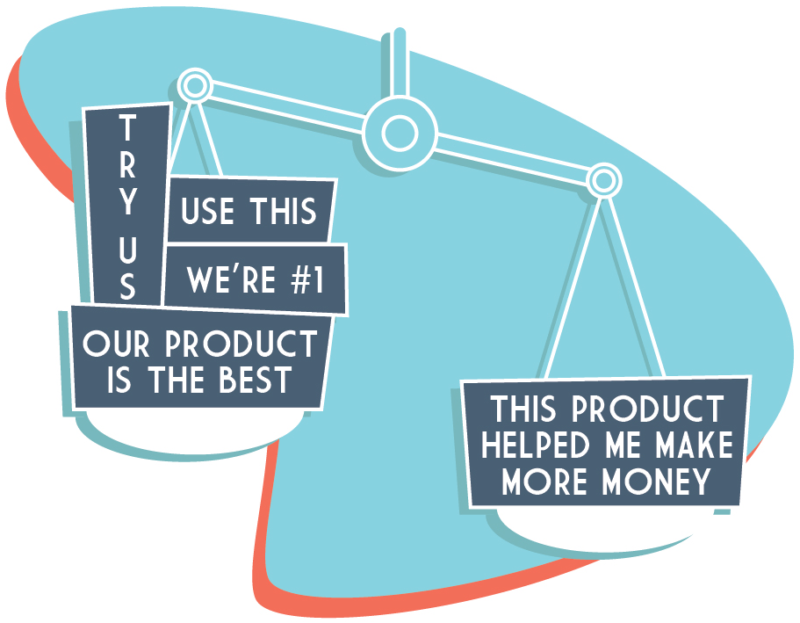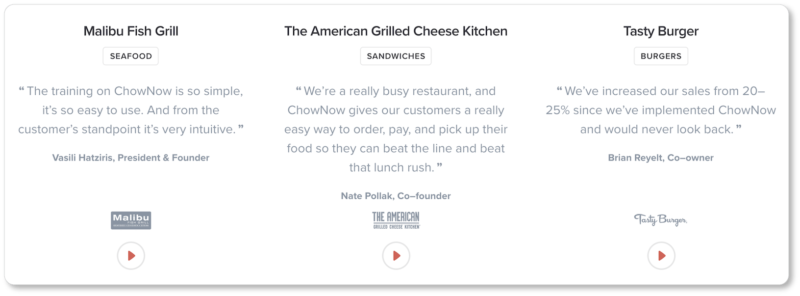- HOME
- Website Building
- Testimonials
- Introducing Customer Testimonials
Introducing Customer Testimonials
- 7 Mins Read
- Posted on April 19, 2018
- Last Updated on October 8, 2024
- By Lauren
Testimonials are among the most powerful and economical tools you have in your marketing toolbox—and on your website. Nielsen’s Global Trust in Advertising Report found that consumers rate testimonials as the second most trusted form of advertising (the first being recommendations from people they know). According to a Search Engine Land report, 72% of customers trust online reviews as muchas they trust personal recommendations. What’s more, the B2B’s Content Marketing Survey reported that testimonials are more effective than any other content marketing tactic.

If you’ve ever done business online—and who hasn’t?—it shouldn’t be a surprise that consumers rank testimonials so highly. After all, product sites and landing pages are intentionally biased, industry reviews are often paid native advertisements, and the majority of businesses only put one foot—their best one—forward publicly.
Testimonials from independent customers, on the other hand, offer personal accounts of real-world successes from people who don’t have a financial stake in a prospect’s purchase decision.
That’s why nearly all of us look for feedback, ratings, or reviews of a product or service by these independent customers before we make a purchase. As a business, you can be as long-winded as you want about the benefits of your product; but a one-sentence testimonial from an unbiased outsider will nearly always draw more prospects into your sales funnel than a traditional hard sell will.
Benefits of a good customer testimonial
A good testimonial does many things at once:
- It affirms the claims you’ve made about your product or service in your marketing materials, verifies your legitimacy, and creates trust
- It demonstrates that you have a history of offering value to your customers
- It speaks to both your prospects’ objections and their desired results through a short, compelling (readable) story
- It builds community within and among your users
- It converts people who are on the fence about your product
- It advertises your product for you… without your having to spend a single penny on marketing efforts
Despite all of these benefits, a Harvard Business Review report found that the majority of businesses don’t collect customer testimonials.
Our suggestion? If you really want your business to thrive, don’t be among that majority.
What makes a good testimonial?
In the sections that follow, we’ll talk you through the various methods of testimonial collection, give you questions to ask your clients to get better testimonial material, and show you real-life examples of some of the best testimonials we’ve seen. But let’s start with the most obvious question: If a “good testimonial” is, indeed, one of the best marketing tools your business can wield… what makes a testimonial “good”?
It should offer specifics
By “specifics,” we mean details about features, benefits, pain points, solutions, and outcomes. Put a number on it whenever you can—whether that number measures decrease in turnover, increase in profits, or precise customer satisfaction ratings. (“We cut our electric bill by 27%,” “I lost 67 pounds in 8 months,” and so on.)
Compare the claim “James helped our company increase revenue this year” with “Because of James, our company increased its revenue by $375,000 this year.” You’ll see pretty immediately the difference between praise and proof. Because the second version gives a detailed number, it’s bound to have a bigger impact. Specificity allows prospects to better imagine what their lives would look like if they experienced an outcome similar to the one they’re reading about. And imagining is one of the most important steps toward converting.
It should tell a “before and after” story
Tangible results are powerful because they allow your prospects to envision themselves experiencing comparable results in their own lives. Such measurable metrics are their own kind of “before and after” story.
But even in situations where it’s difficult to quantify results, try to choose (or craft) testimonials that offer a compelling story with persuasive outcomes. The more details the testimonial includes, the more believable it’ll be.
Take a look at the difference between these two testimonials, both from Montellese Chiropractic’s website:

Montellese extracted both testimonials from the same review site (Yelp); but frankly, based on the reviews alone, we’d ask for Kristina before we’d ask for Christopher if we were to walk into their chiropractic office today. The first testimonial says little more than that Christopher is “smart,” “good,” “friendly,” and “gives great results.”
And those things may be true. But it sounds like a lot of fluff without facts to us.
The second—and much more compelling—testimonial offers a before-and-after story that describes a real transformation that Dr. Kristina was able to effect (no more knee-popping, no more lower back pain), even though the results of her chiropractic adjustments can’t be explicitly “measured” and quantified.
Pro tip: If your product or service offers clients a visible transformation, feature photographs so that your prospects can see the results with their own eyes.
It should answer an objection
Consider again what the point of the testimonial is: to serve as proof to your prospect that your product is as good as your business says it is. The testimonial is there to help the prospect over that last little hill of doubt or distrust.
That means that a good testimonial preempts your prospects’ objections by raising and answering them—within the testimonial. No matter how many times you think you’ve addressed fears, apprehensions, and objections in your sales copy, prospects will want proof that earlier prospects had the same doubts they currently do.
Seeing their doubts mirrored back to them helps prospects identify with your customers, which in turn makes it easier for them to trust the testimonials your customers have written. Reading about how someone else overcame the same apprehensions that your prospect is struggling with is of no small psychological consequence.
Every time a testimonial raises an objection and then silences it, it reduces the risk your prospect thinks they’re taking. So if you can imagine a variety of different objections that a prospect might have to your product or service, you’ll want to display a different testimonial on your site that addresses each one.
The objection doesn’t have to be raised explicitly—although some of the better testimonials we’ve seen do begin with “I admit, I had my doubts…”
Here’s a testimonial from online ordering system ChowNow that speaks to prospects’ risk aversion. (It’s the testimonial on the left, but we’ve included all three because the one on the right exemplifies the “specificity strategy” we discussed above):

The testimonial raises an objection that prospects are likely to have when implementing any new system in their business: that the learning curve for both employees and customers will be frustrating, time-consuming, costly, or some combination of the three. This objection is quieted nearly as soon as it’s raised with the testimonial’s reference to “simple training.” A ChowNow prospect who has the same desire for simplicity in their system transitions is bound to be drawn in by this account.
It should sound (and look) authentic
Of course this means that your testimonials should be written by actual humans who have actually used your product or experienced your service. That’s a given. But you also want them to speak in their own voices. This is why quoting a customer verbatim during a conversation and having customers make video testimonials for you are such great methods of testimonial acquisition.
It’s also why screen-grabbing comments on social media works so well. People write in their most natural language on social media. And natural language builds trust.
As far as appearance goes, your testimonial should not be displayed as a stand-alone praise-blurb. Give whatever information you can give that will make the accolades seem more legitimate. This means proving that the person who wrote the testimonial is real. It includes:
- Your client’s full name
- The name of their business (if applicable)
- Their position in their company
- Their location (usually the city they live/work in)
- A photo (preferably a headshot)
- Their social media handle or web address, which you can link to
Linking to your customers’ websites gives your prospects a way of checking them out—or even contacting them—in the event that they’re still on the fence about your offering. More importantly for your customer, it provides valuable exposure.
When your prospects know what line of work the testimonial writer is in, it both helps them identify and further legitimizes the review. Your prospects want to know that your client has a real smile and goes by more than a set of initials, yes. But they also want to know that your client has authority and expertise in their industry.
Fine-tuning your testimonials
Here’s the thing: The testimonial is a very specific genre of copy that is also very much an art form. It takes some time to get the hang of; but once you know the elements of an exceptional testimonial, you’re already halfway there.
Of course, now there’s the other half to consider—the half that requires your customers and clients give you the language for your testimonials. They may have already said things about (or to) you; and now it’s a matter of scouring your email, social media platforms, and the internet for solid testimonial material. But you may also have to formulate new questions to pose to your customers and clients, which will help them write you exceptional testimonials.
Indeed, discovering and helping generate testimonial material from your most loyal and enthusiastic customers might be the most exciting part of this process. So let’s get you started.
In the next section, we show you where to look for testimonial material that’s already been written and how to repurpose this found text into a “proper testimonial.” We also explain an important best practice: contacting the writer before you quote them.